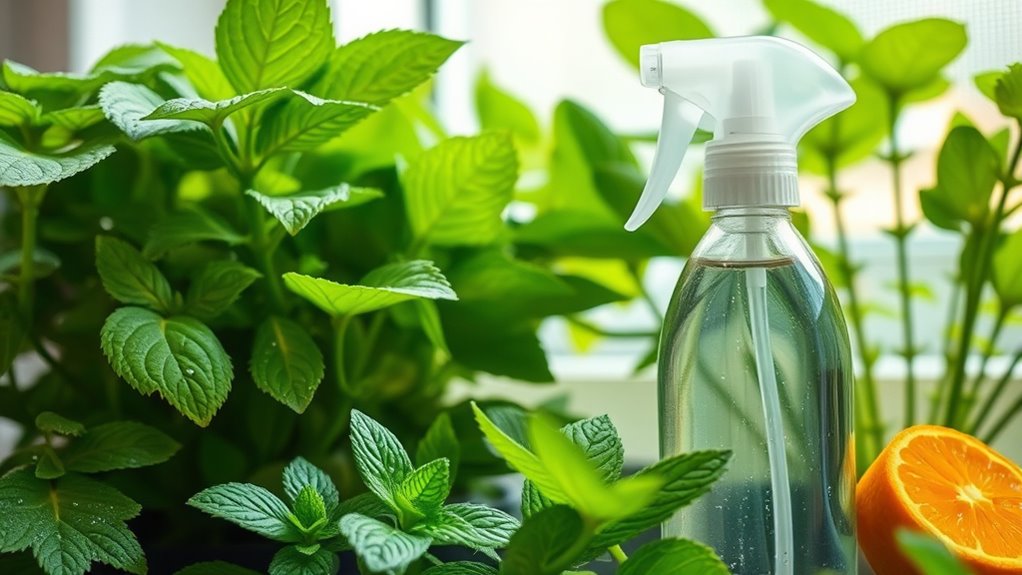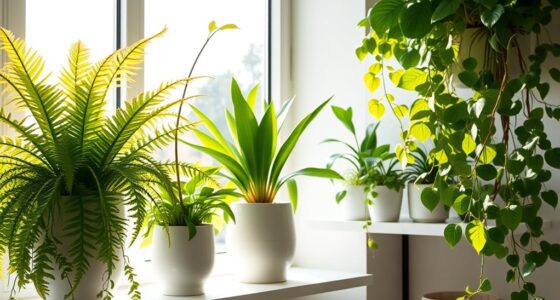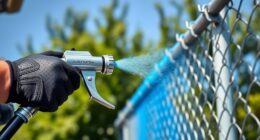To keep bugs away from your indoor plants, regularly inspect for pests like aphids and mealybugs. Use physical barriers such as fine mesh screens and yellow sticky traps. Implement organic sprays made from soap or essential oils to deter insects. Maintain a healthy environment with proper watering, humidity, and ventilation. Don’t forget to encourage natural predators like ladybugs. Discover more effective tips to create a thriving pest-resistant indoor garden.
Key Takeaways
- Use physical barriers like fine mesh screens and yellow sticky traps to block and catch pests effectively.
- Maintain proper humidity and ventilation to deter pests such as spider mites and fungus gnats.
- Regularly inspect plants for pests and isolate any infested ones immediately to prevent spread.
- Apply organic sprays, like soap or garlic solutions, to manage soft-bodied insects naturally.
- Introduce natural predators like ladybugs to help control pest populations in your indoor garden.
Understanding Common Indoor Plant Pests
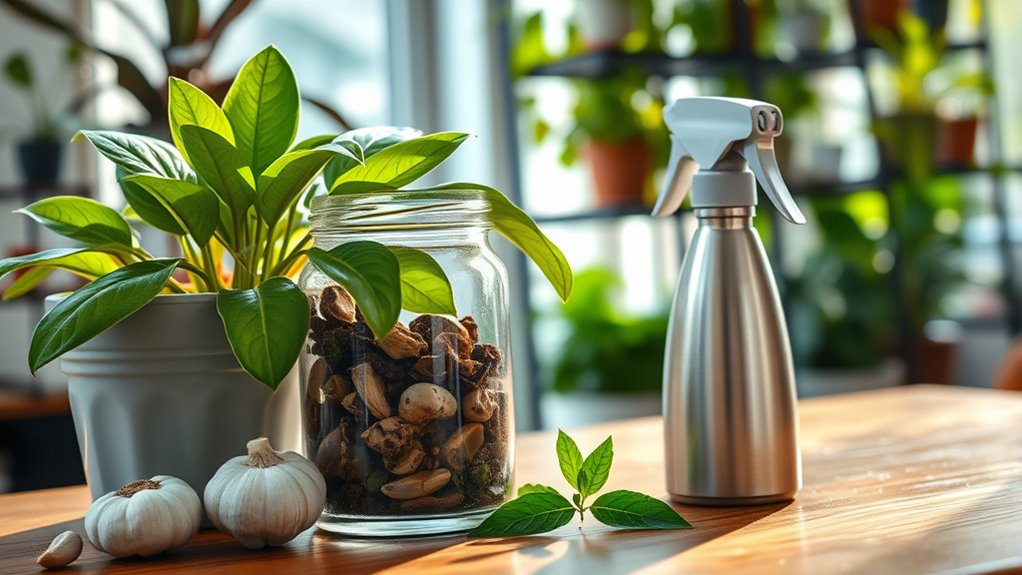
When you nurture indoor plants, it’s essential to be aware of common pests that can harm them.
Aphids, tiny and pear-shaped, feed on your plant’s sap, causing yellowing leaves. You might find them on the undersides of leaves, but hand-wiping or using alcohol swabs can help. Regularly examine plants for signs of pests or damage, especially undersides of leaves, to catch infestations early. Consider implementing preventative measures to reduce the risk of pest infestations. Additionally, maintaining a healthy plant environment can strengthen your plants’ natural defenses against pests.
Aphids are small pests that suck sap from plants, leading to yellowing leaves; treat them with hand-wiping or alcohol swabs.
Fungus gnats thrive in overwatered soil, and you can catch adults with yellow sticky traps.
Mealybugs, fluffy white insects, cause stunted growth, and removing them with alcohol-dipped cotton swabs is effective.
Scale insects appear as bumps on stems and can be scraped off.
Finally, spider mites, thriving in dry conditions, cause speckled leaves and webs. Increasing humidity and using insecticidal soap can control these pests.
Stay vigilant to protect your plants!
Implementing Physical Barriers
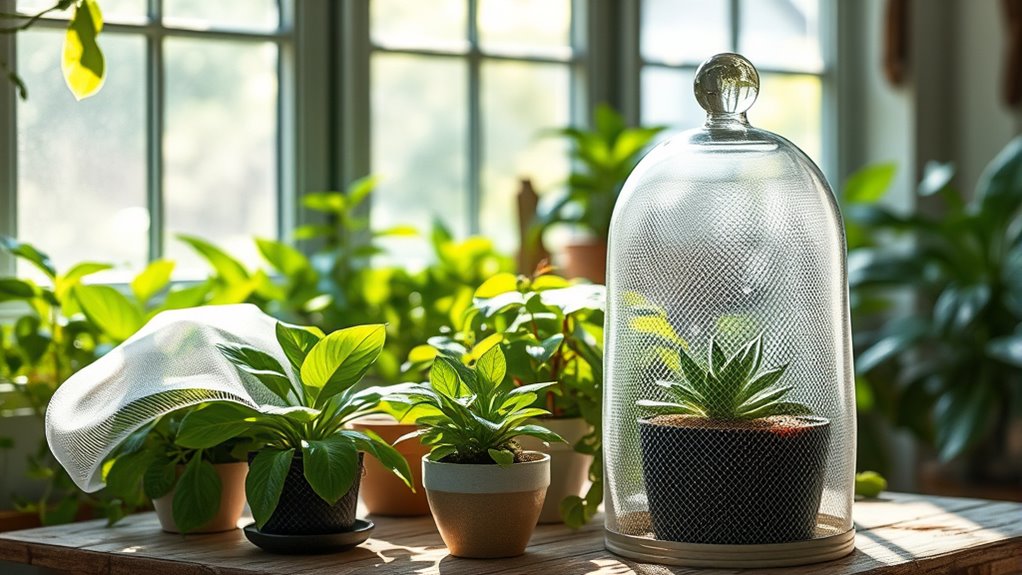
To effectively protect your indoor plants from pests, implementing physical barriers can be a game-changer. You can use fine mesh screens to block tiny insects or yellow sticky traps to catch flying pests like gnats and flies. Exclusion devices provide an additional layer of protection by creating a barrier against unwanted pests. Additionally, ensuring that your plants are in proper drainage pots can help prevent stagnant water, which attracts pests. Using appropriate techniques for applying these barriers can enhance their effectiveness. Regularly adding fresh soil to your pots can also help in preventing pest infestations. Install these barriers around your most vulnerable plants or areas where pests are active. Regularly inspect them for damage to maintain their effectiveness. Choose durable materials that fit your decor and allow for good air circulation and light penetration.
Utilizing Organic Sprays
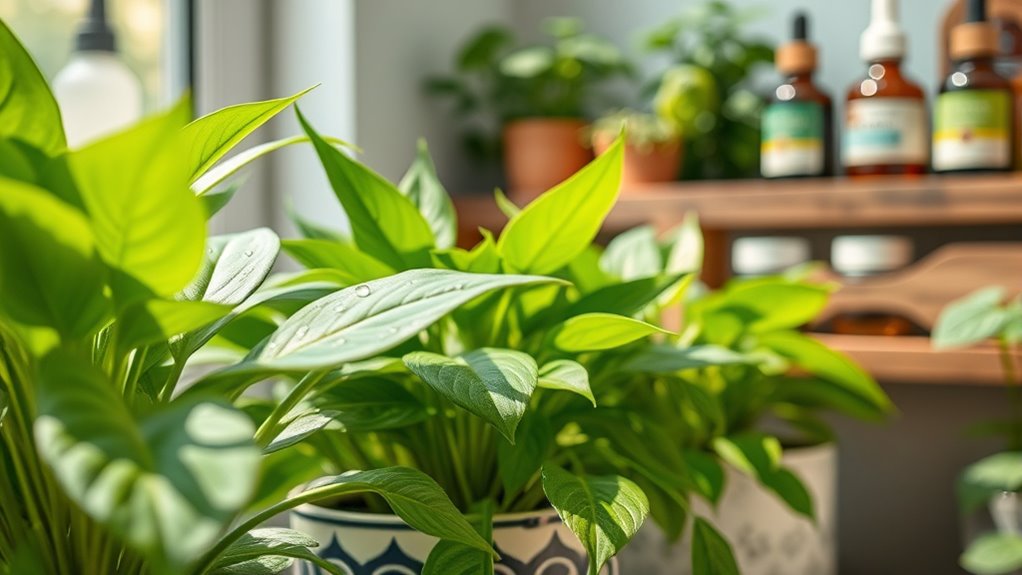
Utilizing organic sprays can be an effective way to keep pests at bay while ensuring a safe environment for your indoor plants.
You can easily make a soap spray using dishwashing liquid or Castille soap, which targets soft-bodied insects like aphids. Combine it with vegetable oil for added potency. For a stronger repellent, consider garlic or hot pepper sprays, both of which deter pests due to their strong odors. Additionally, incorporating essential oils can enhance the effectiveness of your sprays against common pests. Regular monitoring helps catch infestations early, so always test your spray on a few leaves first to avoid damage, and apply it out of direct sunlight. Juices can provide essential nutrients while regular spraying helps maintain pest control, so keep your plants isolated if infested. Maintaining skin hydration is also crucial, as a healthy environment can reduce stress on your plants.
Remember to keep pets away and store your sprays safely to ensure everyone’s safety.
Maintaining Plant Health and Nutrition
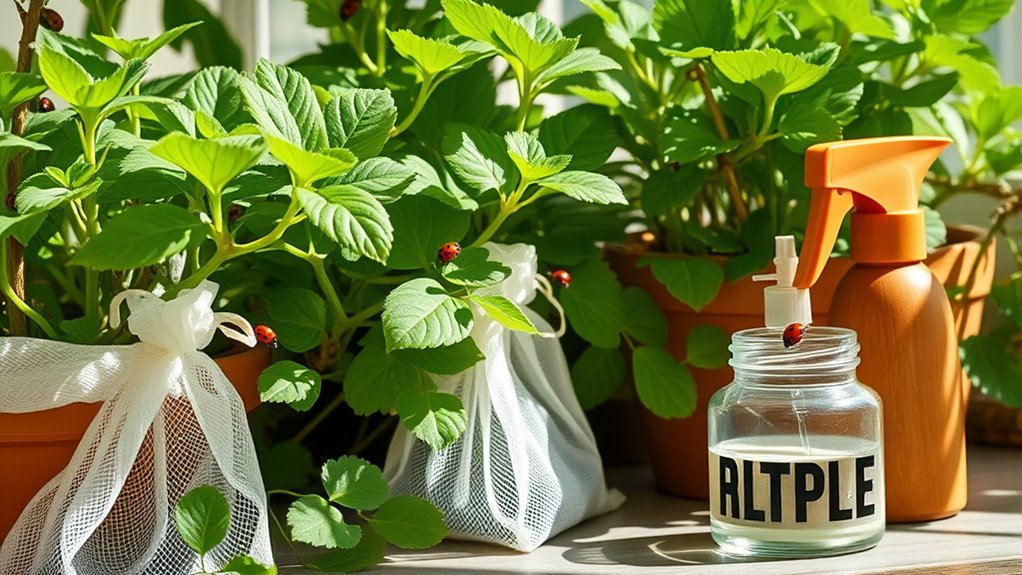
Maintaining the health and nutrition of your indoor plants is crucial for their growth and resilience against pests. Use balanced fertilizers to provide essential nutrients like nitrogen, phosphorus, and potassium. Regularly test your soil to manage pH levels and address any nutrient imbalances. Incorporating organic matter, like compost, enhances soil structure and fertility. Additionally, using solar panels for camping can provide a sustainable energy source for indoor gardening lights. Make sure your pots have proper drainage to prevent waterlogging, and adjust your watering frequency based on each plant’s needs. Use clean, filtered water to avoid introducing contaminants. Furthermore, consider selecting pest-resistant varieties and maintaining a diverse plant collection to reduce pest risks. By focusing on these practices, you’ll ensure your plants thrive and remain less susceptible to infestations. To further minimize the risk of pests, implement preventive measures such as using sterile soil to avoid introducing insect larvae. Furthermore, keeping plants in well-drained soil can help reduce excess moisture that attracts pests. Additionally, understanding the average household energy use can help you evaluate the energy needs of your indoor gardening setup.
Making Environmental Adjustments
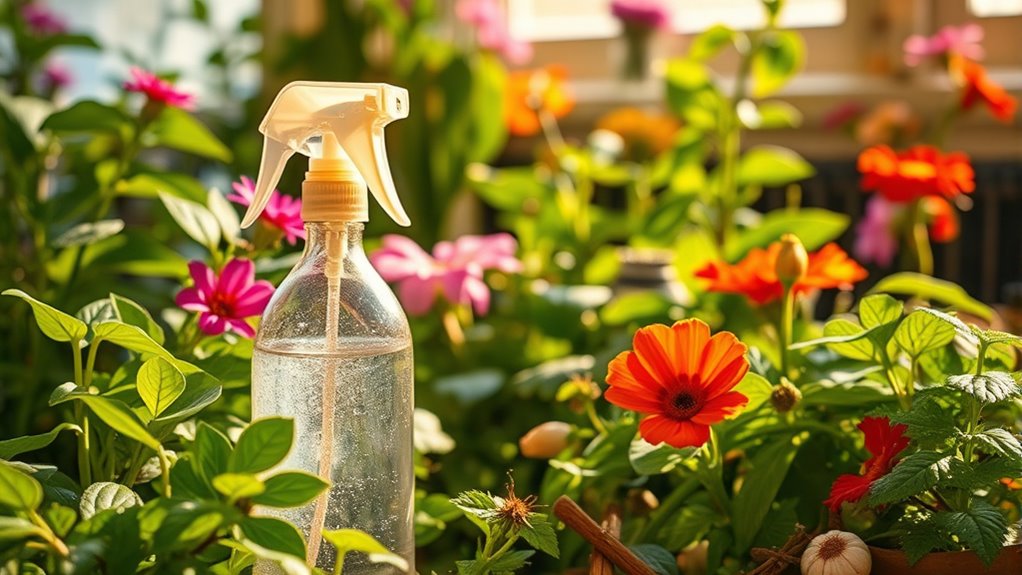
While ensuring your plants receive the right nutrients is important, adjusting their environmental conditions can significantly reduce pest problems.
Start by controlling humidity levels, as pests like spider mites thrive in dry conditions. Maintaining optimal temperatures to reduce stress and make your plants less attractive to pests is crucial, as physical stress can weaken plants and make them more susceptible to infestations. Regular inspections are essential for early detection of pests, allowing you to address any issues before they escalate. Implementing a functional layout for your plant arrangements can also help create a better environment. Additionally, keeping plants well-nourished with omega-3 rich seeds can enhance their overall health and resilience against pests.
Ensure your plants receive the right lighting and manage soil moisture; overly wet soil can lead to fungus gnats. Proper ventilation and adequate spacing between plants are key to enhancing air circulation and preventing stagnant conditions. Keeping the area clean and clutter-free to eliminate hiding spots is vital, and consider using fans to boost airflow. These simple adjustments create an environment that deters pests and promotes healthy growth.
Monitoring for Pests and Quarantine Measures
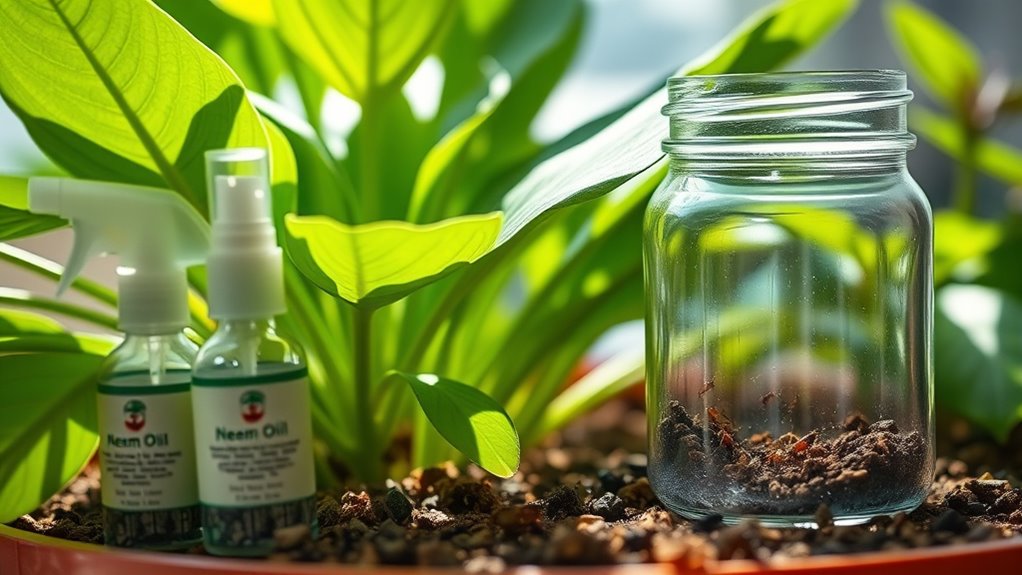
To keep your indoor plants healthy, regular monitoring for pests is essential. Inspect your plants frequently for signs like eggs, webs, or insects. Use a magnifying lens to identify small pests such as spider mites and scale insects. Healthy plants with matching growing requirements are better equipped to resist pest infestations. Engaging in pet therapy can also enhance your emotional well-being, which may indirectly encourage better plant care practices. Additionally, providing proper socialization opportunities for pets can create a harmonious environment that benefits both plants and animals. Freshly squeezed juices, like orange juice, can also provide nutrients to your plants, acting as a natural fertilizer.
Regularly inspect your indoor plants for pests, using a magnifying lens to spot tiny invaders like spider mites and scale insects.
Don’t forget to check all plant parts, including leaf surfaces, bases, and roots. Look out for sticky substances like honeydew, which indicates aphid or scale infestations.
Quarantine new plants for 1-2 weeks before introducing them to your collection, and isolate any infested plants immediately. Clean the quarantine area with soapy water and sterilize any tools used on infested plants.
Regularly inspect nearby plants to catch any potential spread early.
Encouraging Natural Predators and Repellents
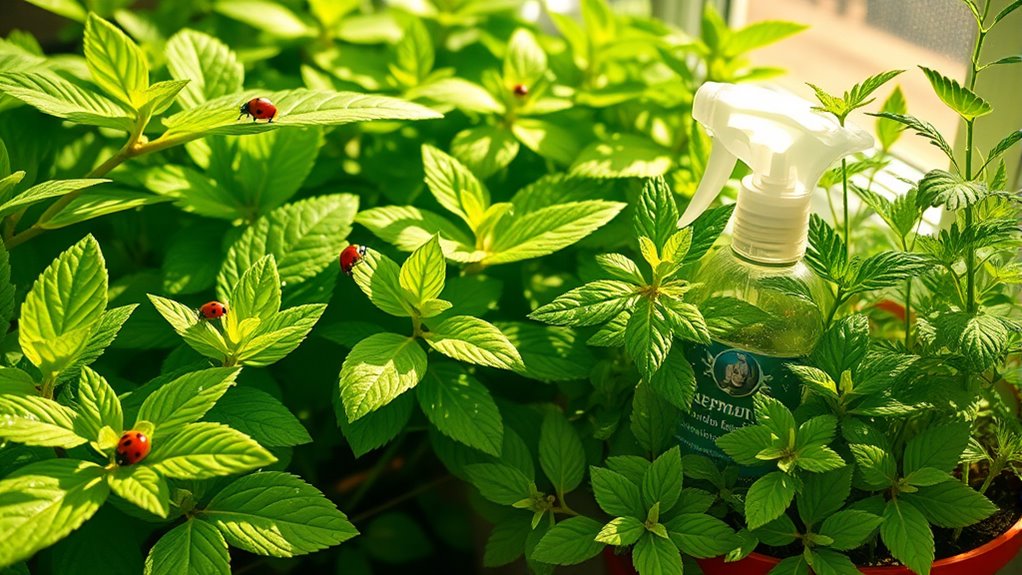
How can you create a thriving indoor garden while keeping pests at bay? Start by encouraging natural predators like ladybugs and green lacewings, which effectively tackle aphids and mealybugs. Additionally, you can introduce beneficial insects such as Cryptolaemus montrouzieri to help control mealybug populations. Regular monitoring for signs of illness in your plants can also help catch pest issues early. Implementing strategies such as integrated pest management can further enhance your ability to keep pests under control. End-of-life care principles can also guide you in nurturing your plants by emphasizing the importance of a healthy environment.
You can also introduce nematodes to combat fungus gnat larvae. For added protection, use essential oils such as orange, mint, and lavender, which repel bugs safely. Mix these oils with water and spray them on your plants. Planting herbs like catnip, basil, and mint near your houseplants can deter pests while providing culinary benefits. Consider using diatomaceous earth or cinnamon in the soil to create barriers and prevent infestations. With these strategies, you’ll cultivate a healthy indoor garden free from pests.
Frequently Asked Questions
What Are the Signs of a Pest Infestation on My Plants?
When you’re checking your plants for signs of pest infestation, look for visible insects like aphids or spider mites.
You might notice leaf damage, such as yellowing or curling. Keep an eye out for sticky residues, which indicate honeydew from pests.
Webbing on leaves can signal spider mites, while general plant decline could suggest a serious issue.
Regular inspections will help you catch any problems early before they spread.
How Often Should I Inspect My Plants for Pests?
You should inspect your plants weekly, especially when you water or fertilize them.
This regular check helps catch any pests early, making treatment easier.
Look for signs of trouble like leaf discoloration or sticky substances.
Use a magnifying lens or your smartphone to spot tiny pests.
If you bring in new plants, quarantine them for a week or two to ensure they’re pest-free before introducing them to your other plants.
Can Indoor Plants Attract Bugs From Outside?
Yes, indoor plants can attract bugs from outside.
When you open windows or doors, insects can easily find their way in, drawn by the light and warmth.
If your plants are fragrant or require high humidity, they may be even more appealing.
To minimize this risk, make sure to inspect your plants regularly and keep your windows and doors closed when possible, especially during warmer months when bugs are more active.
What Household Items Can Help Repel Indoor Plant Pests?
To repel indoor plant pests, you can use several household items effectively.
Mix mild dish soap with water to suffocate pests. Essential oils like peppermint or lavender can deter bugs with their scent.
You might also create a garlic and chili spray for added potency. Consider using physical barriers such as sticky traps or diatomaceous earth to prevent infestations.
Regularly applying these methods keeps your plants healthy and pest-free.
How Do I Properly Dispose of Infested Plants?
To properly dispose of infested plants, start by checking your community guidelines.
You can bag them in clear plastic bags labeled as invasive and place them in the garbage. If allowed, consider burying them deep in the soil to minimize future infections.
Always disinfect your tools after handling infested plants to prevent disease spread.
Avoid composting, as it may not fully destroy pests.
Quarantine any remaining plants to prevent further issues.
Conclusion
Keeping bugs away from your indoor plants doesn’t have to be a chore. In fact, did you know that nearly 60% of houseplants suffer from pest infestations at some point? By understanding common pests and using simple strategies like physical barriers and organic sprays, you can protect your green friends. Remember, a little vigilance goes a long way—monitor your plants regularly, and you’ll cultivate a thriving, pest-free indoor garden that brings joy to your home!

